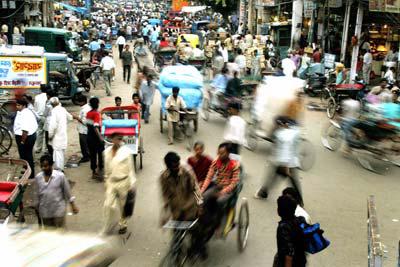The word "demography" was formed from the words "demos" and "grapho". Translated from Greek, they mean "people" and "I write", respectively. The literal interpretation of this phrase is “description of the population”, or “description of the people”. However, the science of demography throughout its history has never been limited to just a description. The subject of her study has always been deeper and wider.
Appearance story
Science, the subject of study of which is the demography of the population, has a specific foundation date. Its beginning was laid in January 1662. It was then that a book was written in London written by the English captain and merchant, self-taught scientist John Graunt. During the period when the author worked on his work, outbreaks of plague and other contagious diseases often occurred in the country. Bulletins on mortality were published weekly in London, and this information was of practical importance, because readers could leave the dangerous city at the first sign of a threat to their lives.

In mournful newsletters, Graunt saw a benefit to science. He studied all the birth and death records published in London over eighty years. At the same time, Graunt drew attention to a number of patterns. In particular, he noted that the number of boys born is more than girls, and this difference is constant and amounts to 7.7%. The scientist drew attention to the excess of mortality over fertility, concluding that the number of people in London increases only due to the relocation of people from the province. A certain pattern was also found in marriage: on average, four births per each union. By the number of births and deaths, the scientist was able to determine the number of inhabitants of the city, and by the age of the dead, the age structure of the population.
The conclusions made were extremely important, because at that time censuses were not carried out. In addition, population statistics, except for the church, were not kept by anyone.
A small book, the text of which was located on ninety pages, became the source of development not only of demography, but also of sociology, as well as statistics.
Further development
The formation of demography as a science in the following centuries took place in two directions. On the one hand, there was a narrowing of the subject of its study. In contrast, an increasing number of various factors influenced the demographic object. At the same time, it became obvious that this science covers an extremely wide area, which is the whole of social life. She could not cope with such a task. That is why from the subject of the study of demography there was a gradual exclusion of issues of economics, social structure, education and upbringing, morality, mobility and public health, and so on. These issues began to be explored by other sciences, such as sociology, pedagogy, ethnography, political economy, medicine, etc.

By the mid-sixties of the last century, many experts began to limit the tasks of demography to the study of the natural displacement of the population. Moreover, the movement here is by no means understood in the physical, but in the general form. And it means change.
Classification
Demographics of the population can be of two types. One of them is natural, and the second is mechanical, or migratory. The second type of population change is the movement of people across the territory. Natural movement is a constant change in the structure and population. It occurs as a result of deaths, births, divorces and marriages. The natural population movement also includes a change in the age and sex structure of residents, which has a direct impact on all demographic processes.
From this we can draw a definite conclusion: the demography of the world shows that the population is in motion and is constantly changing. People are born and die, marry and get divorced, change their place of residence, work, profession, etc. As a result of these processes, the structure and population are constantly changing.
The social nature of demography
The continuous movement of population renewal in mathematical terms can have either a plus sign or a minus sign. At the same time, it happens under the influence of the laws of social development, is one of the components of public life, and therefore has a social character. The demographic area is the result of human activities. Life expectancy, the birth of a family of fewer or more children, celibacy or marriage - all relate to social factors. They are subject to the influence of social laws and are a component of the functioning of the entire social organism.
Moreover, the main elements that make up the social structure of society are social communities and groups. They are associations of people who carry out joint actions. Moreover, all their work is aimed at meeting the needs of representatives of this social group.
Subject of study
The goal that any science pursues is the disclosure of the laws of development of a certain field, which is simply impossible without the establishment of existing laws.
The concept of demography can be disclosed as follows: it is a science whose subject is patterns in the processes of natural reproduction of a population. In this case, the concept of population is deciphered in a specific way. This is not just a collection of people. This is their large number, which has a rich structure necessary for constant renewal. The main quality that defines a population is its ability to reproduce itself. Thus, this concept does not include such aggregates as labor collectives, house dwellers, etc.
Learning objectives
In addition to the knowledge of laws, any science has practical tasks. There are also demographics. Their list includes the following:
- the study of factors and trends of various demographic processes;
- development of measures and forecasts of demographic policy.
A difficult task is to identify trends in the field of natural population movement. And here statistics come to the rescue. Demography selects the indicators necessary in each particular case and evaluates their reliability.
No less importance is attached to the study of various factors of population movement. In this case, as a rule, the causes of processes and phenomena are implied.
Based on the analysis of the results obtained, demographers develop forecasts regarding future changes in the structure and population. Based on their findings, the planning of the national economy is based. These forecasts are important in the distribution of labor resources, training, housing development, etc.
Based on the knowledge of the real trends of population movement processes, the goals of the country's social and demographic policy are determined. The development of such programs is comprehensive, therefore, not only demographers are preparing a list of necessary activities. This is done by sociologists and lawyers, doctors and psychologists, specialists in the field of advertising, etc.
Demographic characteristics
The distribution of the population by any significant difference is understood by its structure. In this case, any characteristic can be taken. The main thing is for the researcher to be of interest. These characteristics are a demographic feature.
Differences between different population groups
What is a demographic attribute? This is the distribution of the population by gender structure and age, nationality, etc. One nation is necessarily different from the other in certain ways. This is a demographic sign. Examples of this are numerous. As a sample, you can take the demographic sign of the Scots and the British.
Sexual structure
The entire population is divided into women and men. This is the demographic sign of gender structure. The main characteristics of this classification are influenced by three factors. The first of them is a biological constant and is determined based on the sex ratio of newborn babies. The second factor is the gender differences of deceased people. The demographic attribute in terms of gender structure also depends on differences in the intensity of migration of men and women.
So, on average, a little more boys are born than girls. The ratio among newborns is stable. For one hundred girls, it is one hundred five to one hundred and six boys. However, physiologists are of the opinion that the male body is less viable in infancy. That is why at the initial stage of the boys a little more dies. Further, mortality rates in sexes are modified. So, in developed countries, more men die due to occupational diseases, injuries and adherence to drinking alcohol and smoking. In developing countries, the opposite is true. There is a higher mortality rate for women. This is due to hard work and frequent childbirth, low social status and malnutrition.
Age structure
The distribution of the population is made by the period from the birth of a person to a certain point in his life. What is a demographic indicator by age structure? This is the distribution of people according to the years they lived, and among infants by months, weeks, days and hours.
The age structure of society has a significant impact on demographic processes and on the size of indicators existing in this area. So, if the percentage of young people among the population is high, then it is possible to predict an increase in the marriage rate, as well as fertility with a decrease in mortality.
The age structure influences not only demographic, but also all social processes. With the duration of a person’s life period, his emotionality, psychology, and also, to a certain extent, his mind are associated. Revolutions and rebellions are more likely in states with a young age structure. Aging societies, where there is a high proportion of older people, on the contrary, are prone to stagnation and dogmatism.
Marriage structure
The demographic attribute of a population is also determined by the form of relations between a woman and a man. Knowledge of the marital structure of society is important for the study of fertility, as well as mortality. Moreover, demography is not only interested in the legal form of marriage. Marital relations, regardless of their legal form, are also investigated by scientists.
Upon marriage, divorce or widowhood, marital status in people passes from one state to another. Throughout society, these cases become part of a single process. Together, they represent the reproduction of the marriage structure.
Knowledge of these processes is important for determining the causes of disintegration and formation of families, changes in fertility and mortality trends.
Creation of a new scientific discipline
Social demography was formed at the intersection of demography and sociology. This is a new scientific discipline. She studies the interplay of social and demographic processes. The study of the natural movement of the population in this discipline is carried out at the micro level. Social demography studies family relationships and personality. This discipline also considers family structure.
The subject of research, which social demography focuses on, are demographic attitudes and behavior, as well as social norms.
Social orientation of demography
Any community of people is formed on the basis of certain signs. The science of demography studies the population by gender, by age, etc. However, the demographic attribute itself is neutral. He gains social status only when considering the general socio-historical context.

What is a demographic attribute in this case? For example, to be a woman or a man does not simply mean possessing physiological attributes inherent in sex. This concept includes the assimilation of the social role system, as well as the corresponding stereotype of behavior, tastes, interests, character traits, etc. Socio-demographic characteristics are factors of a person's femininity or masculinity. This has its pros and cons. On the one hand, the demographic characteristic of social groups is an essential condition for happiness and peace of mind. However, the coin has a downside. The demographic sign of social groups felt by a person can become an obstacle to the formation of a gifted creative person. He will fetter manifestations of freethinking, forbidding to deviate from stereotypes of thinking and behavior, as well as from accepted rules.
Sections and branches of demography
Any science has many thematic parts. Demography is no exception. It consists of various sections that allow you to study specific issues.
So, the task of theoretical demography is to develop a general theory of population. Moreover, all factors are analyzed on the basis of empirical research and put forward scientific hypotheses that reveal quantitative relationships that exist between events and phenomena in the natural movement of the population.
The next section of science is the history of demography. This discipline explores the evolution of knowledge in the field of population movement.
The study of the socio-demographic composition of residents is engaged in demographic statistics. This subsector of scientific discipline is interested in studies of the composition of the population. The subject of study of demographic statistics is nationality and education, qualifications and position, profession, as well as population grouping by source of income, etc. This discipline examines migration flows and the economic burden in families.
Family statistics are collected by household statistics. She pays attention to the quality of food and the availability of durable goods, income and living standards. Her attention area contains data on the number of married couples, their children, etc.
A comprehensive system of information on the dynamics and reproduction of the population is descriptive, or descriptive, demography.
It is no secret that there is a certain relationship between population reproduction and the level of development of the country. Her study is engaged in economic demography. This discipline analyzes the influence of all demographic processes on the proportions and structure of economic growth.
Economic demography includes three areas (sections). They are the following: the economy of growth and quality of the population, as well as the economy of socio-demographic structures.
An interdisciplinary scientific area is ethnic demography. She studies the structure of ethnic migration and the influence of ethno-confessional systems of behavior on the level of population reproduction.
There is demography and political. Her research area is the interaction of socio-political and demographic processes. The subject of this discipline is the political risks of the demographic policy pursued by the state.
In the early seventies of the last century, another branch of scientific discipline arose. Medical demography appeared, which began to study the state of public health, the impact of environmental and social conditions on mortality. At the same time, the main task of this industry was to analyze the causes of population decline, as well as to develop, on the basis of the data obtained, the most favorable conditions for the country's demographic processes.